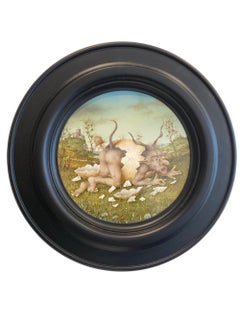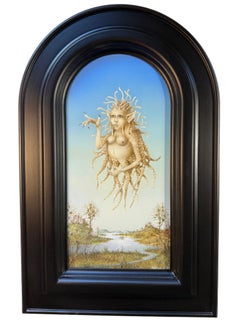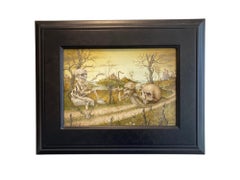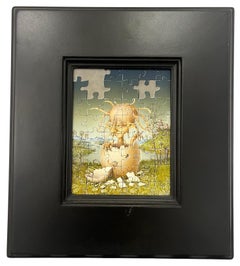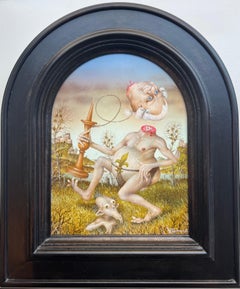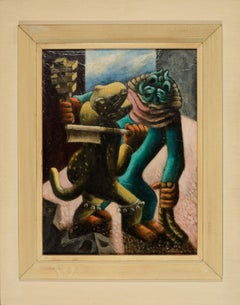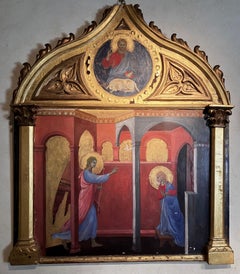Gérard Willemenot Art
French, b. 1943
Gérard Willemenot (1943, Paris, France) graduated as an architect at the School of Art in Paris. After working
asan architect for twenty years, he decided to dedicate himself full-time to an old hobby: painting. Ever since his first exhibition, Willemenot knew he had taken the right decision. He works with egg-tempera on panel. Inspiration sources for Willemenot are old masters as Bosch, Bruegel and Memling. The subjects and technique of these old masters extremely fascinate him. The still life paintings and the use of trompe l'oeil by the Flemish painters of the 16th and 17th century inspire him as well. Gérard Willemenot's work is represented exclusively represented by Morren Galleries in the Netherlands.to
7
7
La Conquête du Ciel Conquest of the Skies Surrealism Contemporary Space Creature
By Gérard Willemenot
Located in Utrecht, NL
La Conquête du Ciel Conquest of the Skies Surrealism Contemporary Space Creature
Gérard Willemenot was born on February 11, 1943.
World War II and his father's deportation to Mautha...
Category
21st Century and Contemporary Surrealist Gérard Willemenot Art
Materials
Panel, Tempera
La Beauté du Diable The Devil's Beauty Surrealism Conteporary Landscape Creature
By Gérard Willemenot
Located in Utrecht, NL
La Beauté du Diable The Devil's Beauty Surrealism Conteporary Landscape Creature
Gérard Willemenot was born on February 11, 1943.
World War II and his father's deportation to Mautha...
Category
21st Century and Contemporary Surrealist Gérard Willemenot Art
Materials
Tempera, Panel
Levitation Surrealist Landscape River Creature Contemporary
By Gérard Willemenot
Located in Utrecht, NL
Levitation Surrealist Landscape River Creature Contemporary
Gérard Willemenot was born on February 11, 1943.
World War II and his father's deportation to Mauthausen had a profound i...
Category
21st Century and Contemporary Surrealist Gérard Willemenot Art
Materials
Panel, Tempera
L'Auto-Stoppeur Surrealism Landscape Skeleton Skull Contemporary
By Gérard Willemenot
Located in Utrecht, NL
L'Auto-Stoppeur Surrealism Landscape Skeleton Skull Contemporary
Gérard Willemenot was born on February 11, 1943.
World War II and his father's deportation to Mauthausen had a profo...
Category
21st Century and Contemporary Surrealist Gérard Willemenot Art
Materials
Tempera, Panel
L'Etrange Puzzle Surrealism Contemporary Creatures Animal Universe In Stock
By Gérard Willemenot
Located in Utrecht, NL
L'Etrange Puzzle Surrealism Contemporary Creatures Animal Universe In Stock - Size is without frame
Gérard Willemenot (1943, Paris, France) graduated as an architect at the School o...
Category
21st Century and Contemporary Contemporary Gérard Willemenot Art
Materials
Panel, Tempera
Louis XVI jouant apres la Revolution Tempera on Panel Surrealism in Stock
By Gérard Willemenot
Located in Utrecht, NL
Louis XVI jouant apres la Revolution Tempera on Panel Surrealism in Stock. Sizes including frame. Size without frame 24 x 18 cm
Gérard Willemenot (1943, Paris, France) graduated as ...
Category
21st Century and Contemporary Contemporary Gérard Willemenot Art
Materials
Tempera, Panel
La Chute d'Icare Tempera on Panel Painting Icarus Falling Mythe Surreel In Stock
By Gérard Willemenot
Located in Utrecht, NL
La Chute d'Icare Tempera on Panel Painting Icarus Falling Mythe Surreel In Stock. Sizes including frame.
Gérard Willemenot was born on February 11, 1943.
The World War and the deportation of his father to Mauthausen will strongly mark his childhood. He is the eldest son of a family of nine children. Very early in conflict with the national education system, he studied art, graduated as a decorator from the Applied Arts and then became a DPLG Architect and Urban Planner, jobs that he mistakenly exercised for twenty-five years!
His childhood and his years of architecture will make him a chronic misfit who hardly likes his time. Unable to remake the world, he will paint it in his own way, offbeat and timeless. Willemenot does not like so-called contemporary painting, which he considers an institutional hoax.
Willemenot's painting is simple. This is so-called “tempera” paint (which he makes himself). This technique, endangered, will be cooked with an immoderate love for the Middle Ages and its mysticism, to which should be added the influence of a few great elders such as Jérôme Bosch, Breughel or Patinir, but also that of contemporary painters such as Albert Drachkovitch or Jacques Poirier...
Category
21st Century and Contemporary Contemporary Gérard Willemenot Art
Materials
Tempera, Panel
Related Items
Tlaloc and the Tiger oil painting by Julio de Diego
By Julio de Diego
Located in Hudson, NY
Tlaloc and the Tiger (1939)
Oil on panel
16" x 12"
23 ¾" x 18 ¾"x 2 ½" framed
Signed and dated (and inscribed) "de Diego 39" lower left.
Provenance: The artist; private collection Ch...
Category
1930s Surrealist Gérard Willemenot Art
Materials
Oil, Panel
Italian Renaissance Style Tempera on Gold Ground Panel Painting the Annunciation
Located in Firenze, IT
This Italian tempera painted on gilt wood gold ground panel is a Tuscan religious artwork in the style of late Renaissance - early Gothic period. The sc...
Category
19th Century Renaissance Gérard Willemenot Art
Materials
Gold Leaf
$8,299
H 48.43 in W 40.16 in D 1.97 in
"Honfleur Street" (2024) By Christopher Clark, Cityscape, Oil & Acrylic
By Christopher Clark
Located in Denver, CO
Christopher Clark's "Honfleur Street" is an original, handmade oil & acrylic painting that depicts an abstracted cityscape bustling with people and the sun brightly reflecting off of...
Category
2010s Surrealist Gérard Willemenot Art
Materials
Oil, Acrylic, Wood Panel
$750
H 12 in W 16 in D 0.5 in
Rebecca at the Well
Located in New York, NY
Provenance:
Dr. James Henry Lancashire, Manchester-by-the-Sea, Massachusetts, by 1925; probably by descent to:
Private Collection, Cumberland Foreside, Maine, until 2018
This unpublished panel is a characteristic work of the Master of the Apollo and Daphne Legend, an anonymous Florentine painter in the circle of Bartolommeo di Giovanni, Domenico Ghirlandaio, and Sandro Botticelli. The artistic personality of the Master of the Apollo and Daphne Legend was independently recognized by Everett Fahy and Federico Zeri at roughly the same moment in time. Fahy originally dubbed this artist the Master of the Ryerson Panels but later adopted Zeri’s name for the artist, which derives from his eponymous works from the Samuel H. Kress collection (Figs. 1-2). Fahy posited that the artist was most likely a pupil of Ghirlandaio active from roughly 1480 to 1510, and that he may be identifiable with one of Ghirlandaio’s documented pupils to whom no works have been securely attributed, such as Niccolò Cieco, Jacopo dell’Indaco, or Baldino Baldinetti. The present painting was first attributed to this master by Everett Fahy in 1989, who became aware of its existence only after publishing his definitive studies on the artist.
The surviving body of work by the Master of the Apollo and Daphne Legend is largely composed of series of panels treating the same theme. In addition to the works illustrating the legend of Apollo and Daphne, there are also series on the themes of Susanna and the Elders and the story of Saint Joseph, among others. The subject of the present panel is drawn from Genesis 24, the story of Isaac. It is possible that our painting relates to another work by the artist depicting the Sacrifice of Isaac formerly in the collection of E. A. McGuire in Dublin, Ireland (Fig. 3), and that these two panels were originally part of a decorative scheme based on the story of Isaac.
Although the Master’s paintings of this type have traditionally been considered painted fronts of wedding chests, known as cassoni, the scale of these paintings and the fact that they are often part of a series indicates that they are more likely spalliera panels—paintings set into furniture or the wainscoting of a room. The biblical episode depicted in this painting centers on the theme of marriage, which suggests that this work was likely commissioned for the domestic interior of a newly married couple. The Master has transcribed into paint even the minute details of this Old Testament story, in which Abraham sends a servant to travel by camel to the land of his father and seek out a wife for his son Isaac. The servant is here shown at the well...
Category
15th Century and Earlier Old Masters Gérard Willemenot Art
Materials
Oil, Tempera, Wood Panel
Rock Me Baby Oil 14 x 20 Framed Water Movement Figurative Portraiture
Located in Houston, TX
LOOK FOR FREE SHIPPING AT CHECKOUT
Rock Me is a 14 x 20 figurative oil painting by E. Melinda Morrison. It was painted in 2019. Rock Me shows the movement of the water rocking the ...
Category
2010s Impressionist Gérard Willemenot Art
Materials
Canvas, Oil, Egg Tempera, Panel
$2,800
H 14 in W 20 in D 0.75 in
The Resurrection of Christ
Located in New York, NY
Provenance:
with “Mr. Scheer,” Vienna, by July 1918; where acquired by:
Jindřich Waldes, Prague, 1918–1941; thence by descent to:
Private Collection, New York
Literature:
Rudolf Kuchynka, “České obrazy tabulové ve Waldesově obrazárně,” Památky archeologické, vol. 31 (1919), pp. 62-64, fig. 5.
Jaroslav Pešina, “K datování deskových obrazů ve Waldesově obrazárně,” Ročenka Kruhu pro Pěstování Dějin Umění: za rok (1934), pp. 131-137.
Jaroslav Pešina, Pozdně gotické deskové malířství v Čechách, Prague, 1940, pp. 150-151, 220.
Patrik Šimon, Jindřich Waldes: sběratel umění, Prague, 2001, pp. 166, 168, footnote 190.
Ivo Hlobil, “Tři gotické obrazy ze sbírky Jindřicha Waldese,” Umění, vol. 52, no. 4 (2004), p. 369.
Executed sometime in the 1380s or 1390s by a close associate of the Master of the
Třeboň Altarpiece, this impressive panel is a rare work created at the royal court in Prague and a significant re-discovery for the corpus of early Bohemian painting. It has emerged from an American collection, descendants of the celebrated Czech industrialist and collector Jindřich Waldes, who died in Havana fleeing Nazi-occupied Europe.
The distinctive visual tradition of the Bohemian school first began to take shape in the middle of the fourteenth century after Charles IV—King of Bohemia and later Holy Roman Emperor—established Prague as a major artistic center. The influx of foreign artists and the importation of significant works of art from across Europe had a profound influence on the development of a local pictorial style. Early Italian paintings, especially those by Sienese painters and Tommaso da Modena (who worked at Charles IV’s court), had a considerable impact on the first generation of Bohemian painters. Although this influence is still felt in the brilliant gold ground and the delicate tooling of the present work, the author of this painting appears to be responding more to the paintings of his predecessors in Prague than to foreign influences.
This Resurrection of Christ employs a compositional format that was popular throughout the late medieval period but was particularly pervasive in Bohemian painting. Christ is shown sitting atop a pink marble sarcophagus, stepping down onto the ground with one bare foot. He blesses the viewer with his right hand, while in his left he holds a triumphal cross with a fluttering banner, symbolizing his victory over death. Several Roman soldiers doze at the base of the tomb, except for one grotesque figure, who, beginning to wake, shields his eyes from the light and looks on with a face of bewilderment as Christ emerges from his tomb. Christ is wrapped in a striking red robe with a blue interior lining, the colors of which vary subtly in the changing light. He stands out prominently against the gold backdrop, which is interrupted only by the abstractly rendered landscape and trees on either side of him.
The soldiers’ armor is rendered in exacting detail, the cool gray of the metal contrasting with the earth tones of the outer garments. The sleeping soldier set within a jumble of armor with neither face nor hands exposed, is covered with what appears to be a shield emblazoned with two flies on a white field, somewhat resembling a cartouche (Fig. 1). This may be a heraldic device of the altarpiece’s patron or it may signify evil, referencing either the Roman soldiers or death, over both of which Christ triumphs.
This painting formed part of the collection assembled by the Czech industrialist and founder of the Waldes Koh-i-noor Company, Jindřich Waldes, in the early twentieth century. As a collector he is best remembered for establishing the Waldes Museum in Prague to house his collection of buttons (totaling nearly 70,000 items), as well as for being the primary patron of the modernist painter František Kupka. Waldes was also an avid collector of older art, and he approached his collecting activity with the goal of creating an encyclopedic collection of Czech art from the medieval period through to the then-present day. At the conclusion of two decades of collecting, his inventory counted 2331 paintings and drawings, 4764 prints, and 162 sculptures. This collection, which constituted the Waldesova Obrazárna (Waldes Picture Gallery), was first displayed in Waldes’ home in Prague at 44 Americká Street and later at his newly built Villa Marie at 12 Koperníkova Street. This Resurrection of Christ retains its frame from the Waldes Picture Gallery, including its original plaque “173 / Česky malíř z konce 14 stol.” (“Czech painter from the end of the 14th century”) and Waldes’ collection label on the reverse.
The Resurrection of Christ was one of the most significant late medieval panel...
Category
15th Century and Earlier Old Masters Gérard Willemenot Art
Materials
Tempera, Panel
Baptism of Christ
Located in New York, NY
Provenance:
Achillito Chiesa, Milan
Luigi Albrighi, Florence, by 1 July 1955
with Marcello and Carlo Sestieri, Rome, 1969
Private Collection, Connecticut
Exhibited:
Mount Holyoke College Art Museum, South Hadley, Massachusetts (on loan, 2012)
Literature:
Carlo Volpe, “Alcune restituzioni al Maestro dei Santi Quirico e Giulitta,” in Quaderni di Emblema 2: Miscellanea di Bonsanti, Fahy, Francisci, Gardner, Mortari, Sestieri, Volpe, Zeri, Bergamo, 1973, pp. 19-20, fig. 18, as by the Master of Saints Quiricus and Julitta (now identified as Borghese di Piero).
This fine predella panel depicting the Baptism...
Category
15th Century and Earlier Old Masters Gérard Willemenot Art
Materials
Tempera, Wood Panel
Portrait of an Italian Noblewoman
Located in London, GB
15th century, Italian
Circle of Antonio del Pollaiuolo (1429-1498)
Portrait of an Italian Noblewoman
Oil and tempura on poplar panel
With partial inscription: ALZETAPIN
Provenance:...
Category
15th Century and Earlier Renaissance Gérard Willemenot Art
Materials
Oil, Tempera, Wood Panel
Expertised Italian 14th Century Gold Ground on Panel Painting
Located in Roma, IT
Museum-quality gold ground painting from the Renaissance period by Smeraldo di Giovanni.
It depicts the “Virgin of the Roses” seated on a throne h...
Category
15th Century and Earlier Renaissance Gérard Willemenot Art
Materials
Tempera, Wood Panel
$45,056
H 25.6 in W 18.9 in D 2.76 in
Beach with pearls, Eric Cederberg, Oil on panel, Nordic Surrealism, 1950 c.
By Eric Cederberg
Located in New York, NY
Eric Cederberg (1897-1984)
Beach with pearls, ca. 1950
Oil on panel
9 1/10 × 14 3/5 in l 23 × 37 cm
Frame included: 13 3/4 x 19 1/3 l 35 x 49 cm
Signed lower left
Exhibition history...
Category
1950s Surrealist Gérard Willemenot Art
Materials
Panel, Oil
$4,500
H 9.06 in W 14.57 in
The Lonely Road by William Charles Palmer
Located in Hudson, NY
The Lonely Road (1940)
Tempera on panel
12" x 16"
19 1/2" x 23 1/2" x 1 1/2" framed
Hand-signed "Palmer '40" lower center.
Provenance: Midtown Galleries, New York, NY (labels verso...
Category
Mid-20th Century American Modern Gérard Willemenot Art
Materials
Tempera, Panel
Study for a Fish at Sea with Three Flags-Ink, egg-tempera and gold leaf on panel
By Konstantinos Papamichalopoulos
Located in Dallas, TX
Konstantinos Papamichalopoulos was born in Athens, Greece in 1975. He studied painting and printmaking at the Athens School of Fine Arts, where he also received a postgraduate degree...
Category
2010s Contemporary Gérard Willemenot Art
Materials
Gold Leaf
$1,320 Sale Price
20% Off
H 7.88 in W 15.75 in D 1.19 in
Gérard Willemenot art for sale on 1stDibs.
Find a wide variety of authentic Gérard Willemenot art available for sale on 1stDibs. You can also browse by medium to find art by Gérard Willemenot in paint, panel, tempera and more. Much of the original work by this artist or collective was created during the 21st century and contemporary and is mostly associated with the contemporary style. Not every interior allows for large Gérard Willemenot art, so small editions measuring 10 inches across are available. Gérard Willemenot art prices can differ depending upon medium, time period and other attributes. On 1stDibs, the price for these items starts at $2,080 and tops out at $17,860, while the average work can sell for $10,243.
